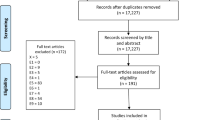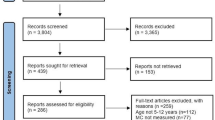Abstract
Background
Physical activity provides many health benefits, yet few children meet the physical activity recommendations. In school-age children, low proficiency in fundamental movement skills (FMS) is associated with low physical activity (PA). It is unknown if the same relationship exists in pre-schoolers (aged 3–5 years).
Objectives
The aims of this review were to firstly evaluate interventions for improving FMS and PA levels in children aged 3–5 years and 5–12 years, and secondly to determine, where possible, if there is a similar relationship between change in FMS and change in PA across both age groups.
Methods
A systematic search of electronic databases was conducted up until 20 July 2017. Controlled trials that implemented an FMS/PA intervention and measured PA levels (objective/subjective) and FMS (objective) in healthy children between the ages of 3 and 12 years were included. Sub-analysis was conducted based on the type of intervention (teacher-led [TL] or teacher educated), sessions per week (< 3 or ≥ 3) and age group.
Results
Search terms yielded 17,553 articles, of which 18 met the inclusion criteria. There was significant improvement in FMS with TL interventions of three or more sessions per week (standardised mean difference = 0.23 [0.11–0.36]; p = 0.0002). In TL interventions, there was a strong negative correlation between moderate–vigorous physical activity (MVPA) and sedentary behaviour (SB) (r = − 0.969; p = 0.031).
Conclusions
There are limited studies measuring both FMS and PA following an FMS intervention, especially in school-aged children. Results indicate that training pre-schoolers at least three times a week in FMS can improve proficiency, increase intensity of PA, and reduce SB, possibly helping to reduce the burden of childhood obesity and its associated health risks.

Similar content being viewed by others
References
World Health Organisation. Global strategy on diet, physical activity and health: childhood overweight and obesity. http://www.whoint/dietphysicalactivity/childhood/en/. 2017.
Ng M, Fleming T, Robinson M, Thomson B, Graetz N, Margono C, et al. Global, regional, and national prevalence of overweight and obesity in children and adults during 1980–2013: a systematic analysis for the Global Burden of Disease Study 2013. Lancet. 2014;384(9945):766–81.
World Health Organisation. Global strategy on diet, physical activity and health: what are the causes? 2017. http://www.whoint/dietphysicalactivity/childhood_why/en/.
Tremblay MS, Gray CE, Akinroye K, Harrington DM, Katzmarzyk PT, Lambert EV, et al. Physical activity of children: a global matrix of grades comparing 15 countries. J Phys Act Health. 2014;11(s1):S113–25.
Janssen I, Katzmarzyk PT, Boyce WF, Vereecken C, Mulvihill C, Roberts C, et al. Comparison of overweight and obesity prevalence in school-aged youth from 34 countries and their relationships with physical activity and dietary patterns. Obes Rev. 2005;6(2):123–32.
Timmons BW, LeBlanc AG, Carson V, Connor Gorber S, Dillman C, Janssen I, et al. Systematic review of physical activity and health in the early years (aged 0–4 years). Appl Physiol Nutr Metab. 2012;37(4):773–92.
Guo SS, Wu W, Chumlea WC, Roche AF. Predicting overweight and obesity in adulthood from body mass index values in childhood and adolescence. Am J Clin Nutr. 2002;76(3):653–8.
Hills AP, King NA, Armstrong TP. The contribution of physical activity and sedentary behaviours to the growth and development of children and adolescents. Sports Med. 2007;37(6):533–45.
Hills AP, Okely AD, Baur LA. Addressing childhood obesity through increased physical activity. Nat Rev Endocrinol. 2010;6(10):543–9.
Strong WB, Malina RM, Blimkie CJ, Daniels SR, Dishman RK, Gutin B, et al. Evidence based physical activity for school-age youth. J Pediatr. 2005;146(6):732–7.
Trost SG, Kerr L, Ward DS, Pate RR. Physical activity and determinants of physical activity in obese and non-obese children. Int J Obes. 2001;25(6):822.
Hinkley T, Teychenne M, Downing KL, Ball K, Salmon J, Hesketh KD. Early childhood physical activity, sedentary behaviors and psychosocial well-being: a systematic review. Prev Med. 2014;62:182–92.
Janssen I, LeBlanc AG. Systematic review of the health benefits of physical activity and fitness in school-aged children and youth. Int J Behav Nutr Phys Act. 2010;7(1):40.
Lubans DR, Morgan PJ, Cliff DP, Barnett LM, Okely AD. Fundamental movement skills in children and adolescents. Sports Med. 2010;40(12):1019–35.
Ulrich DA. Test of gross motor development. Examiner’s Manual. 2nd ed. Austin: Pro-ED Inc; 2000.
Ulrich DA. The test of gross motor development-3 (TGMD-3): administration, scoring, and international norms. Spor Bilim Derg. 2013;24(2):27–33.
Hardy LL, King L, Farrell L, Macniven R, Howlett S. Fundamental movement skills among Australian preschool children. J Sci Med Sport. 2010;13(5):503–8. https://doi.org/10.1016/j.jsams.2009.05.010.
Logan SW, Robinson LE, Wilson AE, Lucas WA. Getting the fundamentals of movement: a meta-analysis of the effectiveness of motor skill interventions in children. Child Care Health Dev. 2012;38(3):305–15.
Veldman SL, Jones RA, Okely AD. Efficacy of gross motor skill interventions in young children: an updated systematic review. BMJ Open Sport Exerc Med. 2016;2(1):e000067.
Lloyd M, Saunders TJ, Bremer E, Tremblay MS. Long-term importance of fundamental motor skills: a 20-year follow-up study. Adapt Phys Act Q. 2014;31(1):67–78.
Cliff DP, Okely AD, Smith LM, McKeen K. Relationships between fundamental movement skills and objectively measured physical activity in preschool children. Pediatr Exerc Sci. 2009;21(4):436–49.
Logan SW, Kipling Webster E, Getchell N, Pfeiffer KA, Robinson LE. Relationship between fundamental motor skill competence and physical activity during childhood and adolescence: a systematic review. Kinesiol Rev (Champaign). 2015;4(4):416–26.
Morgan PJ, Barnett LM, Cliff DP, Okely AD, Scott HA, Cohen KE, et al. Fundamental movement skill interventions in youth: a systematic review and meta-analysis. Pediatrics. 2013;132(5):e1361–83. https://doi.org/10.1542/peds.2013-1167 Epub 2013 Oct 28.
Van Capelle A, Broderick CR, van Doorn N. R EW, Parmenter BJ. Interventions to improve fundamental motor skills in pre-school aged children: a systematic review and meta-analysis. J Sci Med Sport. 2017;20(7):658–66.
Moher D, Shamseer L, Clarke M, Ghersi D, Liberati A, Petticrew M, et al. Preferred reporting items for systematic review and meta-analysis protocols (PRISMA-P) 2015 statement. Syst Rev. 2015;4(1):1.
Maher CG, Sherrington C, Herbert RD, Moseley AM, Elkins M. Reliability of the PEDro scale for rating quality of randomized controlled trials. Phys Ther. 2003;83(8):713–21.
Hozo SP, Djulbegovic B, Hozo I. Estimating the mean and variance from the median, range, and the size of a sample. BMC Med Res Methodol. 2005;5(1):13.
Jones RA, Okely AD, Hinkley T, Batterham M, Burke C. Promoting gross motor skills and physical activity in childcare: a translational randomized controlled trial. J Sci Med Sport. 2016;19(9):744–9.
Cohen KE, Morgan PJ, Plotnikoff RC, Callister R, Lubans DR. Physical activity and skills intervention: SCORES cluster randomized controlled trial. Med Sci Sports Exerc. 2015;47(4):765–74.
Reilly JJ, Kelly L, Montgomery C, Williamson A, Fisher A, McColl JH, et al. Physical activity to prevent obesity in young children: cluster randomised controlled trial. BMJ. 2006;333(7577):1041–3.
Adamo KB, Wilson S, Harvey A, Grattan KP, Naylor P-J, Temple VA, et al. Does intervening in childcare settings impact fundamental movement skill development? Med Sci Sports Exerc. 2016;48(5):926–32.
Roth K, Kriemler S, Lehmacher W, Ruf KC, Graf C, Hebestreit H. Effects of a physical activity intervention in preschool children. Med Sci Sports Exerc. 2015;47(12):2542–51.
Cliff DP, Okely AD, Morgan PJ, Steele JR, Jones RA, Colyvas K, et al. Movement skills and physical activity in obese children: randomized controlled trial. Med Sci Sports Exerc. 2011;43(1):90–100.
Grillich L, Kien C, Takuya Y, Weber M, Gartlehner G. Effectiveness evaluation of a health promotion programme in primary schools: a cluster randomised controlled trial. BMC Public Health. 2016;16(1):679.
Miller A, Christensen E, Eather N, Gray S, Sproule J, Keay J, et al. Can physical education and physical activity outcomes be developed simultaneously using a game-centered approach? Eur Phys Educ Rev. 2016;22(1):113–33.
Bellows LL, Davies PL, Anderson J, Kennedy C. Effectiveness of a physical activity intervention for head start preschoolers: a randomized intervention study [with consumer summary]. Am J Occup Ther. 2013;67(1):28–36.
Bonvin A, Barral J, Kakebeeke TH, Kriemler S, Longchamp A, Schindler C, et al. Effect of a governmentally-led physical activity program on motor skills in young children attending child care centers: a cluster randomized controlled trial. Int J Behav Nutr Phys Act. 2013;10(1):1.
Jones RA, Riethmuller A, Hesketh K, Trezise J, Batterham M, Okely AD. Promoting fundamental movement skill development and physical activity in early childhood settings: a cluster randomized controlled trial. Pediatr Exerc Sci. 2011;23(4):600–15.
Van Beurden E, Barnett LM, Zask A, Dietrich UC, Brooks LO, Beard J. Can we skill and activate children through primary school physical education lessons? “Move it Groove it”—a collaborative health promotion intervention. Prev Med. 2003;36(4):493–501.
Alhassan S, Nwaokelemeh O, Ghazarian M, Roberts J, Mendoza A, Shitole S. Effects of locomotor skill program on minority preschoolers’ physical activity levels. Pediatr Exerc Sci. 2012;24(3):435–49.
Froehlich Chow A, Leis A, Humbert L, Muhajarine N, Engler-Stringer R. Healthy Start–Depart Sante: a pilot study of a multilevel intervention to increase physical activity, fundamental movement skills and healthy eating in rural childcare centres. Can J Public Health. 2016;107(3):e312–8.
Boyle-Holmes T, Grost L, Russell L, Laris BA, Robin L, Haller E, et al. Promoting elementary physical education: results of a school-based evaluation study. Health Educ Behav. 2010;37(3):377–89.
Bryant ES, Duncan MJ, Birch SL, James RS. Can fundamental movement skill mastery be increased via a six week physical activity intervention to have positive effects on physical activity and physical self-perception? Sports. 2016;4(1):10.
Yin Z, Parra-Medina D, Cordova A, He M, Trummer V, Sosa E, et al. Miranos! Look at us, we are healthy! An environmental approach to early childhood obesity prevention. Child Obes. 2012;8(5):429–39.
Nathan N, Sutherland R, Beauchamp MR, Cohen K, Hulteen RM, Babic M, et al. Feasibility and efficacy of the Great Leaders Active StudentS (GLASS) program on children’s physical activity and object control skill competency: a non-randomised trial. J Sci Med Sport. 2017;20(12):1081–6.
Amercian College of Sports Medicine. ACSM’s guidelines for exercise testing and prescription. Philadelphia: Lippincott Williams & Wilkins; 2013.
Bürgi F, Meyer U, Granacher U, Schindler C, Marques-Vidal P, Kriemler S, et al. Relationship of physical activity with motor skills, aerobic fitness and body fat in preschool children: a cross-sectional and longitudinal study (Ballabeina). Int J Obes. 2011;35(7):937–44.
Wrotniak BH, Epstein LH, Dorn JM, Jones KE, Kondilis VA. The relationship between motor proficiency and physical activity in children. Pediatrics. 2006;118(6):E1758–65.
Kambas A, Michalopoulou M, Fatouros IG, Christoforidis C, Manthou E, Giannakidou D, et al. The relationship between motor proficiency and pedometer-determined physical activity in young children. Pediatr Exerc Sci. 2012;24(1):34–44.
Naylor P-J, Nettlefold L, Race D, Hoy C, Ashe MC, Wharf Higgins J, et al. Implementation of school based physical activity interventions: a systematic review. Prev Med. 2015;72:95–115.
Salmon J, Ball K, Hume C, Booth M, Crawford D. Outcomes of a group-randomized trial to prevent excess weight gain, reduce screen behaviours and promote physical activity in 10-year-old children: switch-play. Int J Obes. 2008;32(4):601–12.
Author information
Authors and Affiliations
Corresponding author
Ethics declarations
Funding
No sources of funding were used to assist in the preparation of this article.
Conflict of Interest
Alexander Engel, Carolyn Broderick, Nancy van Doorn, Louise Hardy and Belinda Parmenter declare that they have no conflicts of interest relevant to the content of this review.
Electronic supplementary material
Below is the link to the electronic supplementary material.
Rights and permissions
About this article
Cite this article
Engel, A.C., Broderick, C.R., van Doorn, N. et al. Exploring the Relationship Between Fundamental Motor Skill Interventions and Physical Activity Levels in Children: A Systematic Review and Meta-analysis. Sports Med 48, 1845–1857 (2018). https://doi.org/10.1007/s40279-018-0923-3
Published:
Issue Date:
DOI: https://doi.org/10.1007/s40279-018-0923-3




